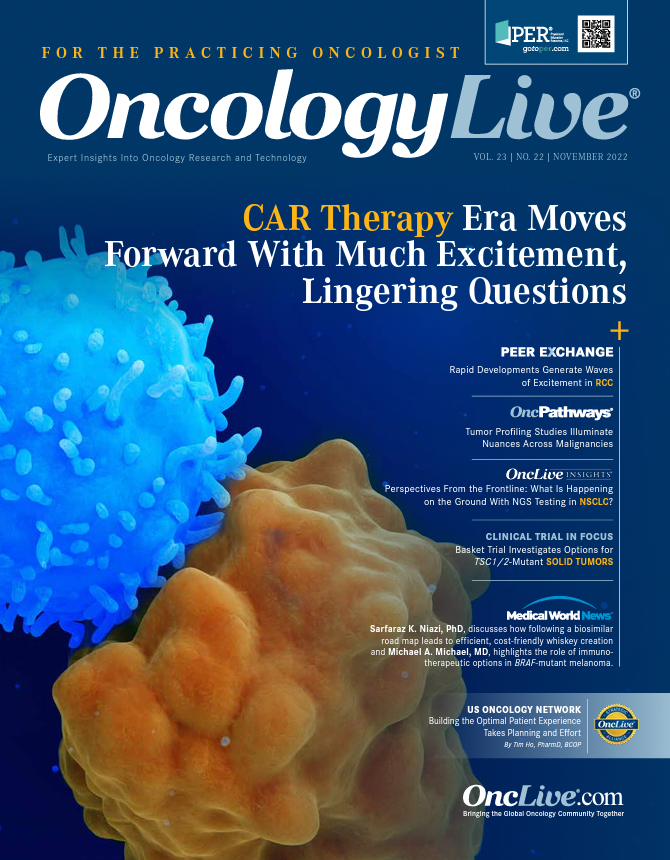Publication
Article
Oncology Live®
Defining Clinical Benefit in Oncology Trials Is Not as Simple as Some May Believe
Author(s):
A core component of any type of therapeutic research is to enhance clinical benefit.
Maurie Markman, MD,

A core component of any type of therapeutic research is to enhance clinical benefit.In appropriately designed, comparative, randomized studies another goal is to determine the superiority or potential equivalence of one therapeutic strategy vs another. Retrospective or prospective analyses of so-called real-world data often attempt to examine the relative clinical benefits of different management approaches in a carefully defined disease setting.
The focus of this commentary is to examine the following question: How does one define meaningful clinical benefit and determine the objective metrics used to critically evaluate if one approach achieves superior outcomes?
Interest in this general topic has been heightened by the recent announcement that after 18 months of follow-up, a monoclonal antibody treatment for early-stage Alzheimer disease “reduced cognitive decline by 27% compared [with] placebo.”1 The questions that must be asked in this instance are: What is the clinical relevance of a 27% decline in cognitive function? How was this objectively evaluated?
Some measures of clinical benefit are quite easy to define and measure. For example, results of a recent study examined the efficacy of 2 combination antibiotic regimens for the treatment of complicated urinary tract infection or acute pyelonephritis.2 The primary measure of efficacy was clinical cure and microbiological eradication of infection. This is a well-accepted standard and objectively evaluable.2 In addition, independent of the established metrics, it is not difficult for even the nonexpert clinician or lay observer to appreciate that the measured outcome could be referred to as clinically meaningful.
A second recently published, noncancer-related, peer- reviewed article provides an illustration of what might be labeled a surrogate measure of relevant clinical benefit. In this study, investigators examined the use of telmisartan, a receptor blocker of angiotensin, to improve walking ability of individuals with lower-extremity peripheral artery disease.3,4 The metric employed in this trial was a 6-month change in 6-minute walk distance comparing telmisartan alone, supervised exercise alone, and the drug with supervised exercise. Of note, prior research had validated a minimum difference of 8 to 20 meters as being clinically important in the analysis of test results.3
Nonexperts would consider the ability to walk a greater distance in a specific period to be a rational surrogate measure of improved function of the lower extremities. Therefore, observed differences in the results between methods used should serve as a reasonable surrogate for what would be considered a consequential clinical outcome.
In the sphere of oncology therapeutics, it is widely accepted that a fundamental goal in most settings is to achieve an improvement in overall survival. However, it is also recognized that documenting such an outcome even in a randomized trial may be difficult, if not impossible. One of the key reasons for this difficulty is the influence of various therapeutic strategies used after individuals leave the controlled setting of the study environment, which may substantially affect survival outcomes.5
Progression-free survival is employed as a primary therapeutic outcome in a larger proportion of therapeutic oncology studies because time to disease progression is more likely to be a more objective measure of the direct effects of a specific treatment strategy in a randomized trial. Further, one can appropriately argue that measurably delaying progression, particularly the development of symptomatic disease, is of meaningful clinical benefit and not simply a surrogate for overall survival.
However, achieving a prospectively defined objective end point that uses a surrogate measure for benefit in a phase 3 randomized trial does not necessarily indicate a cancer study has objectively demonstrated an important clinical effect. For example, consider a recent report of a randomized phase 3 study that examined intraoperative imaging of folate receptor α–positive ovarian cancer.6 Investigators assessed whether this method could “detect macroscopic lesions not detected by palpation and normal white light” among patients with “suspected ovarian cancer scheduled for cytoreductive surgery.”6
The primary efficacy end point was the ability to identify “additional cancer on tissue not planned for resection and not detected by white light assessment and palpation exceeding the prespecified threshold of 10%.” Additional cancer lesions were identified in 33% of patients (n = 105) and in 39.7% of patients who underwent interval debulking surgery (95% CI, 27.0%-53.4% P < .001). Investigators concluded that this imaging strategy “may offer an important realtime adjunct to current surgical approaches for ovarian cancer.”
There is no intent in this discussion to challenge the study’s design, conduct, or statistical interpretation of the documented results. Rather, the sole question being asked is whether the results should be interpreted to suggest the imaging technique provides meaningful clinical benefit for patients or if it serves as a reasonable surrogate for benefit. More evidence may be needed to show whether patients who have additional cancer resected as a result of this approach have superior survival, exhibit a longer time to initial disease progression, or enjoy a superior quality of life.
Alternatively, would it be more appropriate to suggest the study provides a reasonable hypothesis that imaging, identification, and subsequent resection of additional macroscopic cancer within the peritoneal cavity at the time of primary surgical resection may be of meaningful therapeutic value? The demonstration of such benefit would require the conduct of a randomized trial specifically to determine whether the use of this imaging strategy improves an outcome of actual clinical benefit (ie, progression-free survival) compared with treatment without the addition of this diagnostic tool.
References
- News at a glance: AI regulation, renewable energy, and Alzheimer’s therapy. Science. October 6, 2022. Accessed October 26, 2022. bit. ly/3TZ4qGR
- Kaye KS, Belley A, Barth P, et al. Effect of cefepime/enmetazobactam vs piperacillin/tazobactam on clinical cure and microbiological eradication in patients with complicated urinary tract infection or acute pyelonephritis: a randomized clinical trial. JAMA. 2022;328(13):13041314. doi:10.1001/jama.2022.17034
- McDermott MM, Bazzano L, Peterson CA, et al. Effect of telmisartan on walking performance in patients with lower extremity peripheral artery disease: the TELEX randomized clinical trial. JAMA. 2022;328(13)1315-1325. doi:10.1001/jama.2022.16797
- Bonaca MP, Hess C, Beckman JA. Telmisartan and walking performance in peripheral artery disease. JAMA. 2022;328(13):1302-1303. doi:10.1001/jama.2022.14912
- Broglio KR, Berry DA. Detecting an overall survival benefit that is derived from progression-free survival. J Natl Cancer Inst. 2009;101(23):1642-1649. doi:10.1093/jnci/djp369
- Tanyi JL, Randall LM, Chambers SK, et al. A phase III study of pafolacianine injection (OTL38) for intraoperative imaging of folate receptor-positive ovarian cancer (Study 006). J Clin Oncol. Published online September 7, 2022. doi:10.1200/JCO.22.00291










